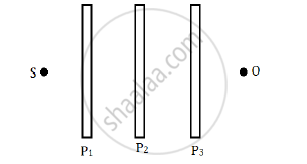Advertisements
Advertisements
प्रश्न
Three identical polaroid sheets P1, P2 and P3 are oriented so that the pass axis of P2 and P3 are inclined at angles of 60° and 90° respectively with the pass axis of P1. A monochromatic source S of unpolarised light of intensity I0 is kept in front of the polaroid sheet P1 as shown in the figure. Determine the intensities of light as observed by the observer at O, when polaroid P3 is rotated with respect to P2 at angles θ = 30° and 60°.

उत्तर

The ray of light passing through polaroid P1 will have intensity reduced by half.'
`I_1=I_0/2`
Now, the polaroid P2 is oriented at an angle 60° with respect to P1.
Therefore, the intensity is
`I_2=I_1cos^2 60=I_0/2xx1/4=I_0/8`
Now, the polaroid P3 is originally oriented at an angle 90 − 60 = 30°. Hence, when P3 is rotated by 30°, the angle between P2 and P3 is 60°. Therefore, the intensity is
`I_3=I_2cos^2 60=I_0/8cos^2 60=I_0/8xx1/4=I+0/32`
Similarly, when P3 is rotated by 60°, the angle between P2 and P3 is 90°.
Therefore, the intensity is `I_3=I_2cos^2 90=I_0/8xx0xx0`
APPEARS IN
संबंधित प्रश्न
What dose a polaroid consist of?
How does one demonstrate, using a suitable diagram, that unpolarised light when passed through a Polaroid gets polarised?
The refractive indices of water for red and violet colours are 1.325 and 1.334 respectively.
Find the difference between the velocities of rays for these two colours in water. (c = 3 × 108 m/s)
What does a polaroid consist of? How does it produce a linearly polarised light?
What is unpolarised light?
State Brewster’s law.
Discuss about Nicol prism.
Can reflection result in plane polarised light if the light is incident on the interface from the side with higher refractive index?
To ensure almost 100 per cent transmissivity, photographic lenses are often coated with a thin layer of dielectric material. The refractive index of this material is intermediated between that of air and glass (which makes the optical element of the lens). A typically used dielectric film is MgF2 (n = 1.38). What should the thickness of the film be so that at the center of the visible spectrum (5500 Å) there is maximum transmission.
An unpolarized light beam is incident on the polarizer of a polarization experiment and the intensity of light beam emerging from the analyzer is measured as 100 Lumens. Now, if the analyzer is rotated around the horizontal axis (direction of light) by 30° in clockwise direction, the intensity of emerging light will be ______ Lumens.
